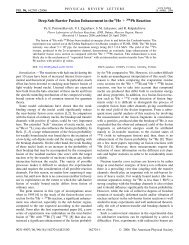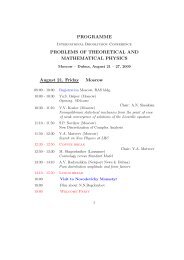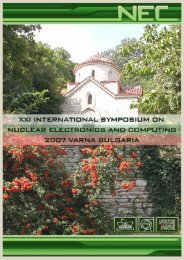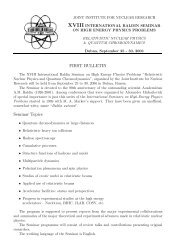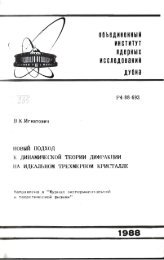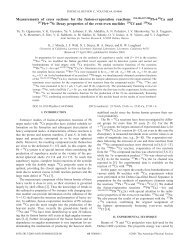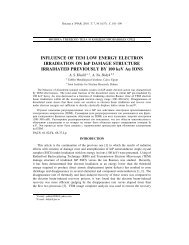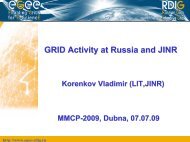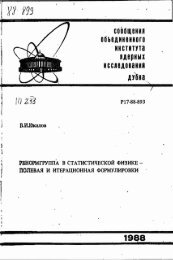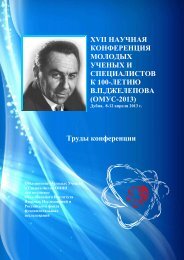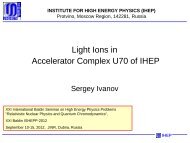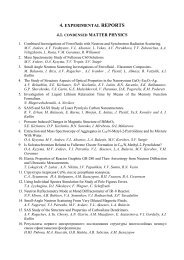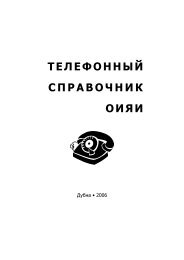Joint Institute for Nuclear Research Relativistic ... - Index of - JINR
Joint Institute for Nuclear Research Relativistic ... - Index of - JINR
Joint Institute for Nuclear Research Relativistic ... - Index of - JINR
Create successful ePaper yourself
Turn your PDF publications into a flip-book with our unique Google optimized e-Paper software.
DETERMINATION OF FAST NEUTRON SPECTRUM BY A DEFORMATION OF<br />
THE REFERENCE SPECTRUM EXPANDED ON LEGENDRE POLYNOMIALS<br />
ACCORDING TO REACTION RATES IN THRESHOLD DETECTORS<br />
1<br />
S.Korneyev, 2 A.Khilmanovich, 2 B.Martsynkevich<br />
1<br />
<strong>Joint</strong> <strong>Institute</strong> <strong>for</strong> Power and <strong>Nuclear</strong> <strong>Research</strong>-Sosny, Minsk, Belarus;<br />
2<br />
B.I.Stepanov <strong>Institute</strong> <strong>of</strong> Physics, Minsk, Belarus<br />
S<strong>of</strong>tware <strong>for</strong> neutron spectra unfolding use experimentally determined reaction rates in<br />
threshold detectors and energy dependence reaction cross-section in a range from 0.025 eV to<br />
20 MeV (see, <strong>for</strong> example, [1]) For high neutrons energies (up to 100 MeV and more) the<br />
in<strong>for</strong>mation on energy dependence <strong>of</strong> reaction cross-section is not sufficient.<br />
In the present work the method <strong>of</strong> spectra unfolding <strong>for</strong> fast neutrons in a range 0.2 …<br />
100 MeV, based on use <strong>of</strong> the modified method <strong>of</strong> effective threshold cross-sections and a<br />
method <strong>of</strong> de<strong>for</strong>mation <strong>of</strong> a reference spectrum expanded on Legendre polynomials.<br />
In traditional approach a de<strong>for</strong>mation applied to find <strong>of</strong> a required differential spectrum φ(E).<br />
Authors propose to use de<strong>for</strong>ming function in the <strong>for</strong>m <strong>of</strong> expansion on Legendre<br />
polynomials <strong>for</strong> a finding <strong>of</strong> integrated spectrum F(E). It is shown that as F(E) is<br />
monotonously decreasing function aspiring to zero at approach to the maximum energy <strong>of</strong> a<br />
spectrum. This function can be presented shorter number <strong>of</strong> required factors a m <strong>of</strong> a<br />
polynomial. In the developed program the reactions cross-sections was taken from library [2],<br />
<strong>for</strong> those reactions which do not have cross-sections above 20 MeV results from [3] are used<br />
up to 150 MeV. The account <strong>of</strong> such "tails" allows calculating more precisely effective cross<br />
section, especially <strong>for</strong> the reactions having high thresholds.<br />
The developed program was applied to fast neutron spectra unfolding in Quinta<br />
facility irradiated by deuterons in the energy range 1 - 8 GeV (<strong>JINR</strong>, LHE, Dubna)<br />
1. W.N. McElroy, S. Berg, T. Crockett, R. G. Hawkins, "A Computer-Automated Iterative<br />
Method <strong>for</strong> Neutron Flux Spectra Determination by Foil Activation, Vol. I: A Study <strong>of</strong> the<br />
Iterative Method," AFWL-TR-67-41 (September 1967)<br />
2. M.B. Chadwick, et al., ENDF/B-VII.0: Next Generation Evaluated <strong>Nuclear</strong> Data Library<br />
<strong>for</strong> <strong>Nuclear</strong> Science and Technology, UCRL-JRNL-225066 (October 2006)<br />
3. A.J. Koning and D. Rochman, <strong>Nuclear</strong> <strong>Research</strong> and Consultancy Group (NRG), TENDL-<br />
2011 http://www.talys.eu/<br />
96



